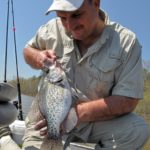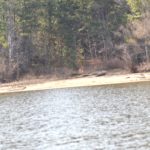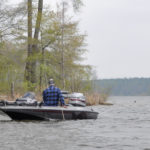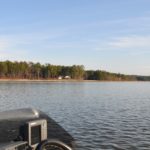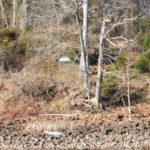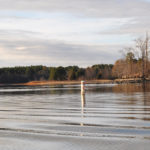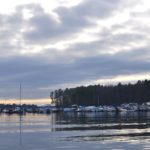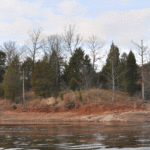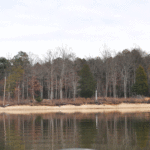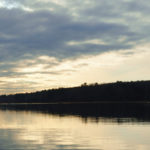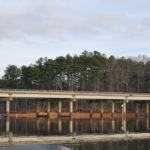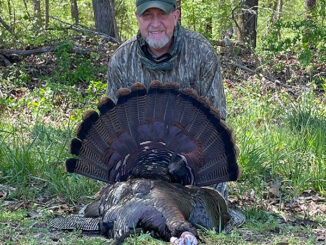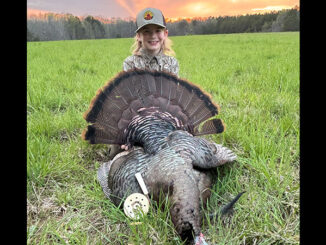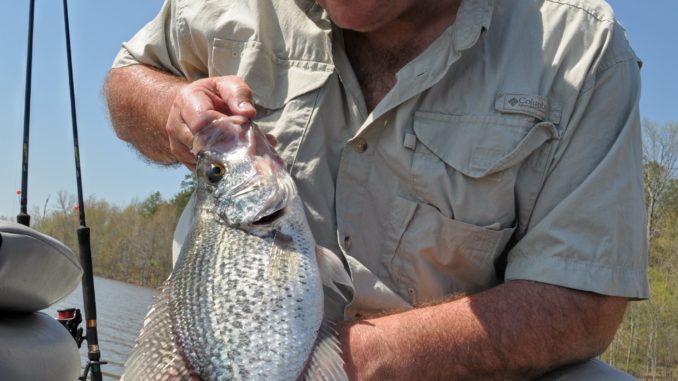
It’s never too ‘early’ to sample this Triangle-area lake’s fine crappie fishing.
Ask most crappie fishermen when they’d rather be targeting slabs, and most all of them will say spring: March, April or May.
That’s because water temperatures at most reservoirs across North Carolina will be just below or at the magical 68-degree mark during those months, and anglers can catch a boxcar load of crappies beating the banks with minnows. Just find a blowdown and drop a crappie minnow with a split-shot a foot up the line and a 1- or 2-inch cork a few feet farther up and wait for a white or black papermouth to slurp it down.
That’s the conventional wisdom. But conventional wisdom is, well, conventional. It ain’t always right.
Crappie experts — guys who fish tournaments for these outstandingly great-tasting lake denizens that school in large numbers and can hit the 3-pound mark — know spring is the second-best time to catch these fish.
“I’d rather start in January,” said Bud Haynes, a slab master and guide on Kerr (Buggs Island) Lake. “Then, February is really good.”
But those months are two of the coldest North Carolina has to offer, often with sub-freezing temperatures and featuring ice, sleet or snow storms.
Rod King of Durham, one of the top tournament crappie fishermen in North Carolina’s Piedmont, agrees with Haynes.
“February is really good,” he said. “That’s when you can catch staging fish — and usually some big ones.”
King knows one lake like the back of his hand, and he prefers to fish the 12,410 acres at Falls of Neuse Lake instead of the two other prime Triangle-area impoundments — B. Everett Jordan and Shearron Harris — for crappies.
It’s a standing joke that if King — who has won more than 100 tournaments around the Triangle — is in the field at any crappie tournament on Falls Lake, his name is pre-written on the winner’s check and champion’s trophy.
A devoutly Christian, King is no longer interested in adding more hardware to his collection. A member of Durham’s Riverside Baptist Church sportsman’s outreach, King organizes crappie tournaments, pays his entry fee and, if he wins, his name is written on a slip of paper and anglers draw for his name. The lucky angler wins all the first-place prizes.
“The keys to finding crappie in February is the weather — wind and water,” said King, a 48-year-old ex-Marine. “Fish are going to be either out on ledges in deep water or moving to shallow-water areas. And they’ll move a long way in a creek in a day or two, depending on the water temperature and wind. If it’s a south wind and warm and the water temperature ticks up a few degrees, in some creeks, they’ll move right into one and two feet of water in February. Then if it switches around to the north and blows cold for a few days, they’ll go back to deeper water.”
Most of the crappie fishing at Falls Lake occurs in the mid-portion of the lake, at Ledge and Big Lick creeks and at the NC 50 bridge. If the water level is high enough, King also fishes Little Lick Creek.
The shallow, upper portions of the lake just south and entirely north of the I-85 bridge are marked by a narrow river channel and decidedly treacherous with stump-filled flats. However, some anglers launch at the Eno River ramp off Red Mill Road near Farrington and have great success in the river.
So here’s a look at 10 top crappie spots in Falls Lake as revealed by its premier slab slayer, Rod King.
“I’ve got lots of places I can (find crappies), and I don’t mind sharing them,” he said.
1 — Ledge Rock roadbed
36 03 348N/78 43 169W
This roadbed about 200 yards north of the Ledge Rock launch ramp will be a good spot to fish, according to King, if the weather’s cold. The submerged road is where old Boyce Bridge Rd. crossed the creek before the lake was impounded. The sunken remains of the bridge (pilings) are favorite deep-water slab hangouts.
“But if the wind’s been blowin’ from the south for a few days, the crappie will run up in the shallows, in two or three feet of water, at the north end of the creek,” King said.
Best fishing technique for deep crappie will be weighted drop-shot type rigs with live minnows. If the fish are shallow, King will use long crappie rods slow-trolled in front of the willows at the shallow end.
2 — Osprey Nest Point
37 03 821 N/78 43 040 W
The Osprey Nest Point is on the west side of Ledge Creek, 300 or 400 yards northwest of the roadbed.
“The creek channel bends just in front of this bank,” King said, “and the sun beats on it all day long in February, so it warms up good and attracts baitfish and crappies. It’s got rock on it, so that helps it warm up faster than surrounding water.”
Most people with spider rigs slow-troll — King calls it “oozing” — back and forth along the channel in front of this bank.
A spider rig is a boat fitted with six or eight B&M crappie poles of 10- to 16-feet in length and 1/16th-ounce leadhead jigs tipped with crappie minnows or skirts.
“Your (trolling) speed definitely needs to be 1 mph or less,” King said. “You need to stay as close to the channel as your can (with lures running 1 to 2½ feet deep).”
The key to February fishing is the sun because “the longer the days get, the better off you’ll be,” King said. “Crappie start making their moves toward the banks when the sun’s shining and the south wind starts to blow. If you get those conditions in February, the first full moon that month you’ll catch some hawgs, even if the water temperature is in the 40s.”
3 — Mouth of Ledge Rock
36 02 585 N/78 43 197W
King says this spot is a deep-water area with flats on either side. One of the rare homes that can be seen from the lake is visible on the east shoreline at about 10 o’clock if the boat is facing south
“You’ll be fishing in 13 to 14 feet of water; the crappie will be on the bottom if it’s cold weather,” said King, who said wind and sun will dictate whether crappie can be caught here as well.
“If we get a south wind, they’ll go to the back of (Ledge) creek,” he said. “Then, if we have a cold snap, they’ll run all the way from two to three feet of water back out here. I’ve seen it happen in one night, and that’s a move of a mile.”
4 — Old Car on the Bank Hole
36 02 113 N/78 43 486W
This spot is just to the southwest a few hundred yards from the mouth of Ledge Rock and near the bank.
A junker is on a steep bluff about 40 feet from the water. No one yet has figured out how the car got to this spot or why. There’s no road in the thick woods off Olive Grove Church Rd., which is a mile or more away.
“You fish right off the shoreline in front of the junked car,” King said. “The creek channel runs close to the shore.
“I’ve caught some really big crappie there. If we’re having a harsh winter in January and February, it’s a great place. The creek channel is like a highway to ’em. They’ll either be moving in the channel going to the shallows or headed to the main lake to go somewhere else.”
For deep fishing, King recommended a crappie jig or a plain live-bait jig tipped with a minnow.
“If you want a skirt on a crappie jig here, use an umbrella skirt, not a curlytail,” he said.
5 — Point at Rollingview
36 01 686N/78 43 802W
This spot is across a narrow cut from the northern tip of Rollingview Recreation Area.
“There are shallow points on either side of a deep channel here, and it’s got black rocks that’re mostly in the sun all day and warm up the water, which attracts baitfish and crappies,” King said.
During February, crappie will move from Ledge Creek through this bottleneck to the main lake, often feeding on baitfish hanging around the rocks.
“It’s like a busy gateway to the upper lake where (crappies) go to spawn,” King said. “They’re like salmon and go back to spawn at the same places they were born. You gotta be careful though, because it’s got some rocks that’ll wreck your lower unit if the water’s low. Anything’s liable to happen to you here with low water.
“Largemouth bass also hang out at this point.”
6 — Rollingview Marina
36 00 426 N/78 42 508W
Another good deep area during cold spells is Rollingview Marina at the mouth of Big Lick Creek.
“The best way to catch crappie here is to drift back and forth in front of the marina,” King said. “Crappie will be staging just outside in the river channel. As the days get longer, these fish will move toward the back of Big Lick.
“But if it’s a cold winter, these fish will stay right in front of Rollingview Marina in 25 feet of water.”
7 — Cedar Point/Big Lick Creek
36 00 098 N/78 43 092W
This spot is on the right side of the creek about 300 yards southwest of the marina. It is marked by a building-size rock base stretching 100 feet and emerging from the water that supports a steep bluff with cedar trees on top.
“I usually back out in 15 feet of water and use my depth-finder to locate fish, depending on the water, sun and wind that day,” he said. “Crappies could be anywhere from seven to 14 feet deep.”
King said the unique-looking point could be an excellent spot for early spring crappie because the sub-surface terrain is loaded with rocks that retain heat during sunny days. He said it’s a general principle of fishing for trophy crappie on any lake in February is rocks will attract and hold crappies that are near a travel-route channel. And the cedar point at Big Lick qualifies.
“If you have three or four days of warm weather, then three or four days of cold weather, the crappie will just move up and down that rock,” he said.
An extra bonus, if a sportsman likes other wildlife, is the top of the bluff often is a strutting zone for wild turkey gobblers.
“Sometimes you’ll see an old gobbler dancin’ up there,” King said.
8 — White Bank Cove
35 59 831 N/78 43 109W
The first “spawning flat” King recommends is a spot that holds fish during warm spells in February or late in the month when the water usually has heated to a comfortable level and isn’t likely to cool significantly.
Across Big Lick from the cedar point and a little farther west, the flat is a nondescript cove — except for an almost white, chalky-looking bank at its northeast side.
“This is an expansive flat with seven or eight feet of water, off the (creek) channel, that heats up on sunny days,” King said. “You often see gulls in here, diving at balls of bait. That usually means crappie are here. Often it smells ‘fishy’ here, and I think that’s the shad schools.
“This is an area where you can troll fast with curlytail jigs or Triple Ripple tails. If the crappie have gotten this far (west) in the creek, the water’s warmed up enough to keep ’em here.”
9 — Standing Timber Hole
35 39 352N/78 43 409W
This is an area near the back of Big Lick Creek with still-erect tree trunks that were flooded when the lake was opened in 1981.
“Oh, yeah, I’ve caught a lot of big crappie in those trees,” King said.
This back section of Big Lick also has a sunken road bed, the remains of Wentz Drive.
“Once you go across the road bed, that’s where (crappie) are spawning,” King said. “I’ve won more tournaments fishing that standing timber than any place on the lake.”
King said anglers lose a lot of jigs in the timber, but they also will catch big crappie.
10 — Highway 50 Hump
36 00 950N/78 41 450W
Just about everyone who fishes Falls Lake knows about the “Highway (NC) 50” bridge, but not all are aware a big “hump” lies on the northwest side of the span with an end the drops off into the river channel..
“It’s an underwater island that comes up six or seven feet from the surface,” King said. “It holds a lot of crappie and bass.”
King said the sweet spot is where the south end of the island drops off into the channel.
“In the summer, you can fast-troll it,” he said, “but in early February, crappie on warm days come up on it and feed on the rock at the end where it drops off.
“Also, when the wind comes out of the south, it piles up water on the rip-rap at the bridge, the bait move in and the crappie and bass move in to feed on them.”
King laughed and said the only problem is sometimes crappie and bass anglers tussle for the best spots at the bridge.

